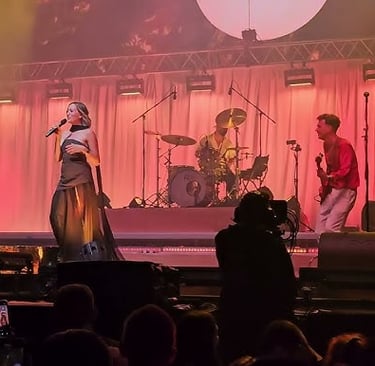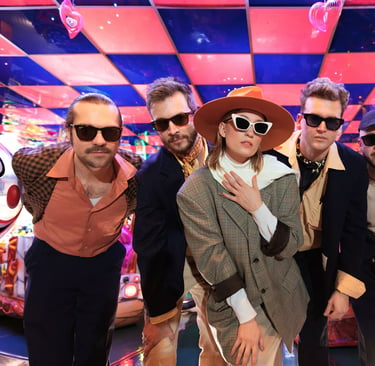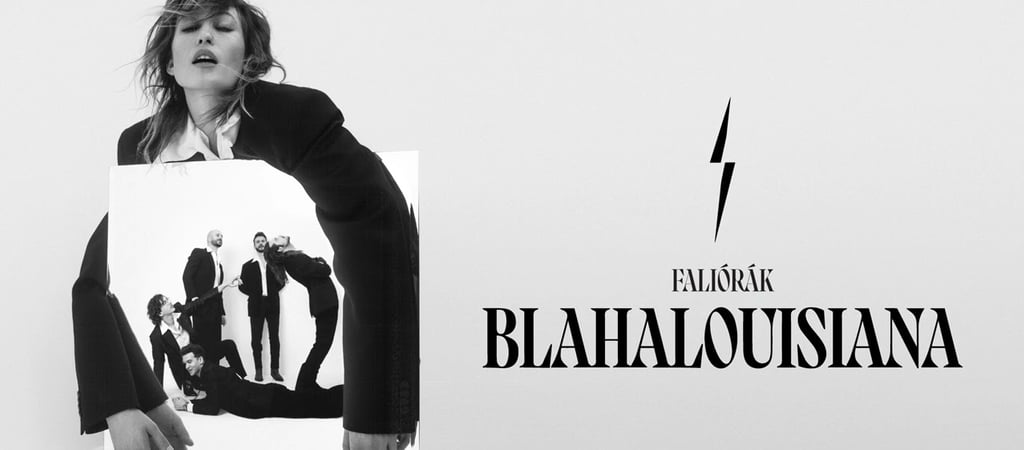Blahalouisiana
A soul-stirring blend of vintage glam rock and Brazilian-inspired groove, Hungarian spirit blazing through every riff and lyric.
The Rise of Budapest’s Soulful Rock Icons
Blahalouisiana emerged in Budapest’s music scene in 2012, forming a distinct presence through their wild mix of glam rock, soul, and retro pop. Led by the charismatic Rebeka Bodó, whose smoky voice channels both Nina Simone undertones and Fleetwood Mac sensibility, the band quickly drew attention for mixing flamboyant style with musical integrity. Their early performances in local bars featured smoky brass sections, staccato guitar lines, and flamboyant stage presence—uncommon in a city where electronic music dominated clubs. From their first demos, they declared themselves storytellers: songs about broken hearts, midnight streets, and defiant glamour. Their aesthetics—retro suits, glittering dresses, vintage cars in videos—paired with subversive humor created cult status. But beneath the veneer lies serious musicianship: the horn section’s tight groove, the rhythm elements’ Brazilian samba scents, and the guitar riffs’ power-channeling energy. Their rise signaled a revival of analog warmth and narrative soul in Hungarian pop culture, establishing them as more than a cover act—they became cultural icons forging emotional resonance through bold sound and visual identity.
Sound, Style, and Cinematic Musical Identity
The band’s sound is immediately recognizable: a combination of swing brass, smooth bass grooves, vintage guitar riffs, and a cinematic rhythm section that evokes Brazilian samba, Latin undertones, and soul rhythms. Rebeka Bodó’s voice—a smoky alto with theatrical reach—unfurls languid melodies over fast-moving grooves. The band layers dynamic arrangements: walking basslines, sharp brass fractures, lush organ chords, and retro drum claps. Their style graces kitschy glam aesthetic—fedoras, leather fringe, wide lapels—evoking 1970s London mod culture, juxtaposed with a sense of cinematic storytelling. Lyrics often plumb emotional depths: longing, autonomy, love gone wrong, and existential humor, all delivered in Hungarian with occasional English hints. The integration of musical sophistication (Brazilian rhythm, soul heft) with pop immediacy and visual theatricality positions them beyond nostalgia—they craft evocative worlds in sound. Their performances command attention: each instrumental breakdown becomes studio-cinematic; each chorus builds to orchestral grandeur. They’re not just playing songs—they’re playing scenes in emotional film reels.
Cultural Resonance and Influence in Hungary’s Modern Music Scene
Blahalouisiana holds a special place in Hungary’s evolving music culture. They revived interest in analog instrumentation, live horn sections, and Brill Building-style songwriting at a time when electronic pop dominated. Younger bands cite them as inspiration to marry classic groove with modern relatability. Major Hungarian festivals like Sziget began offering early evening slots to them in groovy tents, introducing their vintage soul to international stages. Their presence reignited public interest in vinyl, smoky lounge culture, and live instrumental performance. Interviews highlight how they encouraged creative education: their workshops on songwriting and live energy design attract music school students. Their songs began featuring in Hungarian film soundtracks, adverts, and high-fashion campaigns. Even state cultural shows include them as examples of modern yet retro innovation. Blahalouisiana became signatures of national musical identity—asserting that Hungarian pop need not be derivative; emotional, instrumental, and theatrical music still has a profound home.
Albums: Musical Evolution and Artistic Milestones
Their debut album Blahalouisiana and the Greenboar carved identity with energetic twelve tracks of vintage groove, calling deeply to longing and urban nightlife. Competent brass, guitar riffs built for redemption, and body-moving beats set the tone. The sophomore release Tales of Blahalouisiana deepened narrative ambition: song stories of lost mates, neon loneliness, and existential longing across city nights. Shadowy ballads like “Hold Your Breath” displayed lyrical tension, while dance tracks like “Latin Quarter Twist” invoked club-bedroom duality. Their third album Budapest Blues Scandal offered a more mature voice—songs confronting heartbreak and beauty with blues-infused piano lines and orchestral sweeps. Lyrically and musically, the band shifted from retro homage toward cinematic emotional drama—each album refined cohesion between narrative, groove, and vintage flare. Deluxe albums include acoustic or remix versions, allowing fans to experience orchestration stripped down or rhythm reimagined. The progression between albums reflects deepening artistic vision: from riff-heavy roots toward layered sound storycraft reflecting Budapest’s soul mirror, heartbreak intensity, and unapologetic vintage cool.
Where to Watch and Listen
Blahalouisiana’s music and visual artistry are widely accessible across streaming services such as Spotify, Apple Music, and Deezer, each offering full album catalogs and curated playlists. Their official YouTube channel hosts high-quality music videos and filmed live performances. Their physical CDs and vinyl records—including deluxe editions featuring behind-the-scenes commentaries and artwork—are sold via their website and select Hungarian indie music stores, often including liner notes in Hungarian and English. Concert DVDs and Blu-rays capture notable live shows in Budapest theaters and major European tour dates. For those attending in person, ticketing is organized through their official portal and festival preorder systems. Fans can purchase signed memorabilia and fashion products—caps, vintage jackets—through merchandise platforms tied to their tours. Social media channels share behind-the-scenes glimpses into rehearsal routines, songwriting sessions, and tour visuals, deepening audience connection beyond performance.


Visual Storytelling: Music Video World-Building
Blahalouisiana’s music videos are mini-films rather than promotional snippets, each a visual narrative drenched in retro glamour. Videos often portray characters from a world of decadence—flourishing in film noir lighting or pastel neon—directed with a vintage lens texture. One track shows Bodó wandering carnival streets at night in stark neon shadows; another features choreographed dancers in a humid swimming pool. Video production often involves vintage film cameras, bold color grading, and cinematic voiceovers that echo 1960s black-and-white intros. The visual work deepens the musical identity: viewers see stylized distortion of Budapest’s nocturnal streets, 1950s-American car culture, or romantic melancholy enacted with retro surrealism. These videos bring the songs to life not through literal interpretation, but symbolic worlds—ripped from cinematic memory, colored with romantic irony. In doing so, they elevate the band’s songs into emotional experiences, building a strong visual cult identity and layered meaning. Each clip becomes a story piece that reinforces the song’s emotional stakes: longing, resilience, defiance—all dressed in stylized stylistic bravado.
Live Shows: Theatrical Energy and Audience Connection
On stage, Blahalouisiana turns theaters into re-staged vintage lounges. Rebeka glides between songs, microphone vintage stand in hand, commanding attention with smooth charisma and dramatic flair. Brass sections punctuate every guitar riff; the rhythm section propels dancing in the audience’s feet. The stage show includes visual tableaux: ribbon curtains, old car headlights, film-reel backdrops—creating immersion. Between songs, Rebeka interacts with the crowd, bridging emotional void with subtle humor and shared vulnerability. The band’s pacing blends bop numbers with ballads, often finishing encores with gospel-like choruses where audience participation becomes a communal vow of mischief or broken love. Critics describe their lighting design as retro-noir meets Broadway striptease—mood shifting within minutes from nightclub hush to foxtrot fury. These live shows elevate the catalog, translating studio polish into visceral connection. For many fans, attending a live concert becomes a ritual—escapist yet centered in emotional honesty—leaving people breathless, dancing, teary, and invigorated.






Awarded with the Highest Distinction
Blahalouisiana was awarded the Excellence Award for their emotional depth fused with retro elegance, inventive sonic storytelling, and cultural revival that reshaped Hungary’s musical narrative. It is worth watching because they offer more than music—they deliver cinematic storytelling, energetic rebellion, and timeless groove that demands attention and rewrites what modern rock can feel like when rooted in vintage soul.







